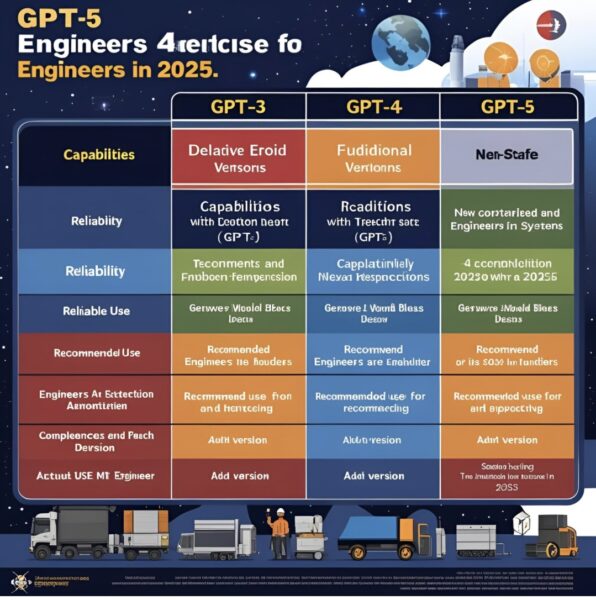GPT-3 vs GPT-4 vs GPT-5 — Which Should Engineers Use?

Choosing the right GPT model matters if you’re an engineer. GPT-3, GPT-4, and GPT-5 each have different strengths in reasoning, reliability, and coding support. In this guide, we’ll compare them side by side and explain which version makes the most sense for software engineers, developers, and technical teams in 2025.
Key takeaways for engineers
- Default to GPT-5 for most engineering tasks: better reasoning, faster iteration, fewer hallucinations in technical contexts.
- Keep GPT-4 as a stable fallback for teams with existing guardrails/prompt libraries targeting 4.x behavior.
- Avoid GPT-3 for serious work; use only for legacy demos or non-critical text tasks.
| Model | Capabilities — What it can do | Reliability / Accuracy | Best Use for Engineers |
|---|---|---|---|
| GPT-3 | Basic text generation and simple Q&A. Limited reasoning, no modern multimodal support by default. | Low — higher hallucination rate, outdated knowledge; fragile on edge cases. | Not recommended for production-grade engineering. Legacy demos or quick drafts only. |
| GPT-4 | Strong general reasoning; good coding help; with 4o variants, can analyze images/UI and discuss code from screenshots. | Medium–High — solid accuracy; still requires verification for complex or domain-specific tasks. | Prototyping, refactoring, writing tests, code review summaries, architecture notes for mid-complexity systems. |
| GPT-5 | Advanced reasoning and planning; faster iteration; stronger coding assistance (from snippets to end-to-end flows); multimodal by default. | High — fewer hallucinations, better consistency under long contexts; still follow best-practice verification. | Preferred for engineers: debugging, system design, data wrangling, CI prompts, API scaffolding, migration scripts. |
Working with AI models like GPT-5 is smoother when you have the right tools. Below are some developer essentials that improve coding efficiency, testing, and daily workflows.
- 💻 High-speed USB — perfect for storing large logs and datasets.
- 🎧 Noise-canceling headset with mic — great for coding focus and online meetings.
- 📹 HD external webcam — ideal for AI-assisted meetings and remote teamwork.
- 🔌 Durable HDMI cable — recommended for dual-monitor coding setups.
Some links are affiliate links. If you purchase through them, we may earn a small commission at no extra cost to you.
What this means in practice
- Green-field work: Start on GPT-5 to get faster drafts, stronger reasoning, and better long-context stability.
- Existing GPT-4 prompts: Keep them, but A/B test GPT-5; many teams see fewer review cycles with 5.
- Compliance-sensitive code: Pair GPT-5 outputs with linters, unit tests, and a small human code review loop.
- Legacy or non-critical tasks: If cost is a constraint, archive GPT-3 for copy drafts only (no critical logic).
Quick decision guide
- Need reliable reasoning + speed? Choose GPT-5.
- Maintaining older 4.x workflows? Keep GPT-4 for stability, evaluate 5 on critical paths.
- Ultra-low stakes text only? GPT-3 can draft, but validate heavily.
Engineer scenarios that benefit from GPT-5
- Debugging: Paste failing tests/logs; ask for likely root causes, minimal diffs, and a rollback plan.
- API scaffolding: Generate OpenAPI spec → client stubs → example requests → Postman collection.
- Data wrangling: Convert CSV → SQL seed scripts; write safe migrations with idempotent up/down.
- Docs/READMEs: Turn scattered comments into task-oriented docs with “quickstart + gotchas”.
- Test strategy: Ask for boundary cases, property-based tests, and CI hints for flaky tests.
Reliability & safety tips (recommended regardless of model)
- Always pin constraints in the prompt: language/runtime versions, frameworks, and style guides.
- Request minimal diffs and self-checks (“explain why this fix is correct; list assumptions”).
- Automate linters + unit tests for every AI-assisted change; block merges on failing checks.
- For sensitive code/PII, run via approved environments and redact inputs where possible.
Why Adopt ChatGPT? General Benefits
ChatGPT has become a go-to AI assistant across industries. For everyday users, it improves productivity by drafting documents, summarizing long reports, generating creative ideas, and providing instant answers to questions. With Plus or Pro plans, users gain access to the latest GPT-4 or GPT-5 models, delivering faster responses, better accuracy, and multimodal capabilities (text, images, and audio).
- Time savings: Generate high-quality text or code in seconds.
- Ease of use: Natural conversation interface — no complex setup required.
- Flexibility: Supports multiple languages and domains, from business to education.
- Value for money: Subscriptions are far more affordable than traditional enterprise software tools.
Why Engineers Should Choose GPT-5 on ChatGPT Plus
While the general benefits apply to everyone, engineers gain unique advantages from ChatGPT Plus with GPT-5 access. Coding, debugging, and system design all require accuracy, reasoning, and efficiency — areas where GPT-5 significantly outperforms earlier models.
- Smarter coding assistance: GPT-5 writes more reliable functions, understands complex frameworks, and adapts to project-specific coding styles.
- Reduced debugging time: By analyzing logs and test results, GPT-5 suggests minimal fixes and explains root causes in plain English.
- Stronger reasoning: Ideal for architecture planning, database migrations, and integrating APIs into existing systems.
- Fewer hallucinations: Compared to GPT-3 and GPT-4, GPT-5 produces more consistent, verifiable outputs — crucial for production-level code.
- Rapid prototyping: From generating OpenAPI specs to writing CI/CD scripts, GPT-5 accelerates iteration cycles.
In short: GPT-3 is outdated, GPT-4 remains serviceable, but GPT-5 is the most engineer-ready model to date. For teams serious about speed, accuracy, and innovation, adopting GPT-5 through ChatGPT Plus is the most practical choice.
FAQ
Q:Do I still need GPT-4 if I move to GPT-5?
Many teams keep GPT-4 prompts for stability while piloting GPT-5 on high-impact tasks. In practice, GPT-5 reduces iteration loops on complex reasoning, so migration usually pays off quickly.
Q: How do I reduce hallucinations in technical outputs?
Constrain the environment (tooling versions), ask for citations or file/line references when possible, and require self-checks (“list assumptions; show why this compiles; propose tests”).
Q:Keep a verification step in CI. Is GPT-3 ever appropriate?
Only for non-critical text drafts where correctness is not essential. For engineering, the opportunity cost usually outweighs savings.
Final Thoughts
Bottom line: GPT-3 is no longer suitable for serious engineering tasks. GPT-4 still works well for stable workflows, but GPT-5 is the clear choice for most engineers — offering stronger reasoning, faster iteration, and more reliable coding assistance.
If you want to try GPT-5 today, upgrading to ChatGPT Plus is the fastest way to get started.
✔️You might also find these helpful:
▶︎GPT-5 Arrives in Microsoft Copilot: Should You Cancel ChatGPT Plus?
▶︎Best Agentic AI Tools for Windows: Automate Your PC Like Never Before
▶︎Why Does Windows Restart Automatically? Causes and Fixes Explained Step-by-Step
▶︎Google Account at Risk? Real Security Threats and Easy Fixes for Windows Users
▶︎WSUS Clients Not Updating? Common Causes and How to Fix Them


